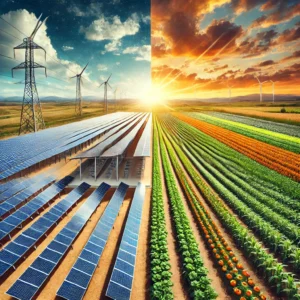🌍 The Tale of Two Farmers: One Sun, Two Dreams
Imagine two farmers, Jake from the USA and Raj from India. Both are struggling with extreme weather—Jake faces heatwaves in Texas, and Raj deals with unpredictable monsoons in Maharashtra.
One day, they hear about solar energy as a way to save on electricity bills. Jake installs traditional solar panels, covering a vast area of his farmland. Meanwhile, Raj tries agrivoltaics, where solar panels are installed above his crops.
Fast forward a year: Jake’s land is dry and lifeless because the solar panels blocked his farmland. Meanwhile, Raj is reaping a double harvest—electricity and crops. Curious? Let’s break it down. ⚡🌱
🌞 What’s the Difference? Agrivoltaics vs. Traditional Solar Farms
| Feature | Agrivoltaics 🌱🔆 | Traditional Solar Farms ☀️ |
| Land Usage | Dual-use: Energy + Farming | Single-use: Only Energy |
| Crop Protection | Shields crops from extreme heat/rain | No protection for crops |
| Water Conservation | Less water evaporation | More water needed for nearby land |
| Energy Efficiency | Higher due to cooling effect | Can overheat, reducing efficiency |
| Cost | Higher initial cost but more returns | Lower initial cost but no farming income |
| Who Benefits More? | Farmers + Energy Producers | Mainly Energy Companies |

💪 How Does Agrivoltaics Work? (Simple Explanation)
Agrivoltaics isn’t as complicated as it sounds! Imagine you’re holding an umbrella on a hot day. You stay cooler, right? The same happens with crops under solar panels.
- Elevated Solar Panels – Solar panels are installed above crops at a specific height so sunlight still reaches the plants but provides partial shade.
- Optimized Light Sharing – Crops get just the right amount of sunlight, and the solar panels absorb the rest.
- Cooling Effect – The crops release moisture, which cools down the panels, making them more efficient.
- Energy Generation – Just like traditional solar farms, these panels generate electricity for homes, farms, or businesses.
In short, it’s like setting up a rooftop solar garden, but on a farm!
🌟 Real-Life Examples of Agrivoltaics Success
1. Grape Farms in France
France is known for its wine, and agrivoltaics is now helping grape farmers protect their crops from extreme heat. Solar panels above vineyards have improved grape quality while producing energy.
2. Japan’s Solar Sharing Revolution
Japan is a leader in agrivoltaics, using elevated solar panels over rice fields. This increases yield while generating electricity for nearby villages.
3. Arizona, USA – Water-Saving Agrivoltaics
In Arizona, agrivoltaics has reduced water usage by 50% for crops like tomatoes and lettuce, while boosting solar energy efficiency by keeping the panels cool.
4. India’s Solar Farming in Gujarat
Farmers in Gujarat are adopting agrivoltaic solar farms to generate electricity while growing crops like wheat and mustard. It’s boosting incomes without sacrificing farmland.
🏆 5 Reasons Why Agrivoltaics Might Be the Future
1. Double Income = More Smiles!
Unlike traditional solar farms that generate just electricity, agrivoltaics offers dual income. Farmers can grow crops and sell electricity. It’s like running a restaurant that also has a bakery on the side! 🍕🥐
2. Crops Love the Shade Too! 🌿
Extreme heat can destroy crops. Solar panels provide shade, reducing heat stress and water loss. It’s like giving your plants a sun umbrella! ☂️
3. More Energy, Less Wastage ⚡
Agrivoltaic panels stay cooler because of plants beneath them, increasing efficiency. Traditional solar panels sometimes overheat, making them less productive.
4. Fights Climate Change 🌎
Less water use, less land wastage, and more greenery—agrivoltaics is an eco-friendly superhero compared to traditional solar farms. 🧘
5. Perfect for Countries with Limited Land
Countries like India and the UK, where land is precious, benefit from agrivoltaics. Why? Because land does two jobs instead of one!
❌ When Traditional Solar Farms Might Be Better
Of course, agrivoltaics isn’t for everyone. Here’s when traditional solar farms make more sense:
- If land is cheap and abundant (like deserts in California, UAE, or Australia)
- If large-scale energy production is the only goal
- If crops grown under panels don’t suit local farming conditions
🔥 FAQs (Because We Know You Have Questions!)
❓ 1. What are the best crops for agrivoltaics?
Answer: Leafy greens (spinach, lettuce), tomatoes, and some herbs thrive under agrivoltaic systems.
❓ 2. Do solar panels affect soil quality?
Answer: No, in fact, they reduce soil erosion and water loss.
❓ 3. Is agrivoltaics more expensive than traditional solar farms?
Answer: Initially, yes. But over time, the combined income from crops + electricity makes it more profitable.
❓ 4. Can I switch my existing solar farm to agrivoltaics?
Answer: Yes, but you might need adjustments like elevated panel structures and soil testing for crops.
❓ 5. Who is already using agrivoltaics?
Answer: Countries like Japan, France, India, and the USA have successful projects running!
🌎 Final Verdict: Agrivoltaics or Traditional Solar Farms?
Agrivoltaics is like a smartphone—it does more than one job. Traditional solar farms are like a basic phone—they do one job well, but that’s it.
If you’re a farmer or landowner, agrivoltaics can be a game-changer. If you’re a large-scale energy producer, traditional solar might still be your best bet.
So, what do you think? Is agrivoltaics the future? Let’s chat in the comments! 🔥
📚 References:
- International Renewable Energy Agency (IRENA)
- National Renewable Energy Laboratory (NREL)
- India’s Ministry of New and Renewable Energy (MNRE)